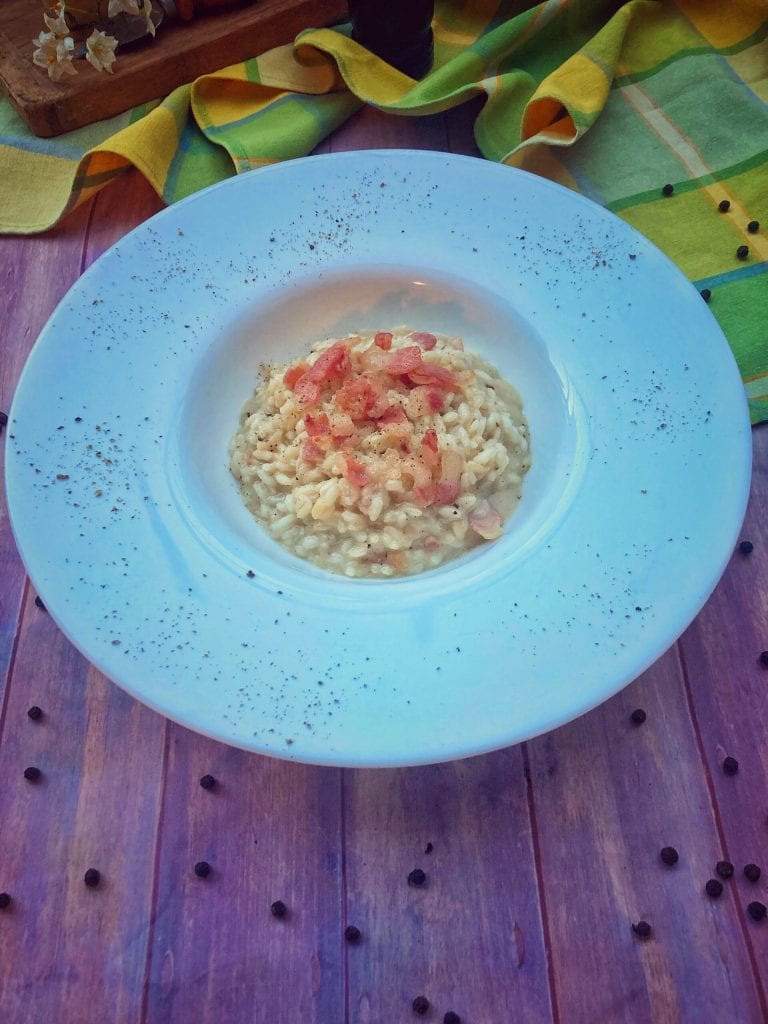Risotto alla gricia is the ‘risotto’ version of the more famous pasta alla gricia.
Cacio e pepe, then amatriciana, gricia, and carbonara: they are related dishes.
Their story is a true family affair, as they all descend from a single recipe: Cacio e Pepe, a Roman specialty, seemingly simple and loved worldwide.
▶Gricia (or griscia) is the mother of amatriciana.
▶Also known as ‘white amatriciana’, it’s the evolution of cacio e pepe, due to the addition of guanciale. So, never use bacon!
▶It probably takes its name from the village where it originated, Grisciano, a small hamlet of Accumuli, in the province of Rieti, on the border with the Marche region.
▶▶Another theory suggests the name might come from ‘Gricio’, a nickname for bakers in 15th-century Rome, who often came from German regions.

- Difficulty: Medium
- Cost: Economic
- Preparation time: 10 Minutes
- Portions: 2 servings
- Cooking methods: Stovetop
- Cuisine: Italian
- Seasonality: All seasons
Ingredients
- 9.5 oz Carnaroli rice (or Arborio)
- 5.3 oz guanciale (preferably from Amatrice)
- 7.1 oz pecorino romano
- to taste whole peppercorns (to grind)
- 8.5 cups vegetable broth
Steps
Toast the rice in a delicate sauté of extra virgin olive oil and onion.
Start the creaming process with hot vegetable broth kept warm.
Fry the guanciale in its own fat.
Add the pecorino and 2 ladles of broth to create a cream. Add another ladle if necessary.
The average creaming of the rice lasts about 20 minutes, a few minutes before, reduce the broth and add the pecorino cream, guanciale, and plenty of freshly ground black pepper.
Adjust salt if necessary, but be cautious as pecorino is already very salty.
Turn off the heat, let it rest for a few minutes, and serve with an additional sprinkle of ground pepper if desired.

FAQ (Questions and Answers)
What type of rice is best for risottos?
The Carnaroli is one of the most used products for preparing risottos because it is characterized by a consistently al dente texture that it maintains for a long time.
It has a high amylose content, which makes the grain more resistant during cooking.
Originating from the city of Arborio, it features medium-large grains and a high starch content.
The Arborio absorbs a lot of liquid during cooking, making it perfect for creamy risottos.
The Baldo is perfect for making all kinds of dishes: baked dishes, timbales, salads, and especially risottos with sauce.
Suitable for preparing creamy risottos and timbales, arancini or salads, Roma Rice should be served just cooked to prevent its grains from disintegrating.
Vialone Nano, characterized by round medium-length grains, is highly prized because, being rich in starch, it quickly becomes creamy: ideal for vegetable-based risottos.

